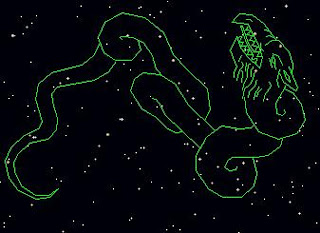Draco, or the Dragon, is a constellation in the northern hemisphere. It was first charted by the Greek astronomer Ptolemy in the 2nd century. In ancient Egypt, the constellation was called Tawaret, after the vigilant, protective goddess of the northern sky, whose body was depicted as part-human, part-lioness, part-crocodile and part-hippopotamus.
In Greek mythology, the constellation Draco was identified with the dragon Ladon, which had a hundred heads and was in charge of guarding the Garden of the Hesperides, the orchard of the goddess Hera where golden apples that gave immortality grew. When Hercules was given the task to steal the apples, he enchanted Ladon with music and put him to sleep before stealing the apples. Hera later placed the dragon among the stars.
Draco is also associated with the dragon that guarded the Golden Fleece and was killed by Jason, as well as with the dragon killed by the Phoenician prince Cadmus before he founded the city of Thebes in Boeotia in Greece. In early Christian mythology, Draco was identified with the serpent that tempted Eve in the Garden of Eden.
The constellation Draco occupies an area of 1083 square degrees and contains five stars with known planets. It can be seen at latitudes between +90° and -15° and is best visible at 9 p.m. during the month of July. For many observers in the northern hemisphere, Draco never sets below the horizon.
The brightest star in the constellation is [3438] gamma Draconis or Eltanin ("the serpent"), an orange giant 148 light-years distant. It lies close to the point directly over London and is sometimes called the "zenith star."
[3445] alpha Draconis or Thuban ("the basilisk") is not a very conspicuous star in comparison. It is a binary star consisting of a white giant with an apparent magnitude of 3.65, more than 300 light-years away from Earth, and a companion that is believed to be either a red or white dwarf. In ancient times, between the years 3942 and 1793, Thuban was the pole star, the closest visible star to the North Pole. It will reclaim that status in the year 20346.
Draco also contains several notable deep sky objects. The Cat’s Eye Nebula, NGC 6543, is a planetary nebula shaped like a blue disc, formed by a bright, hot central star that lost its outer envelope about a millennium ago.
The Spindle Galaxy, NGC 5866, is a lenticular galaxy with a notable dust disk, seen edge-on. It is considered by some to be a candidate for Messier 102, a galaxy it closely resembles.
The Draco Dwarf Galaxy is a spheroidal galaxy and a satellite galaxy to the Milky Way. It has very little interstellar dust and contains mostly old stars; a significant number of red giants, five carbon stars and more than 260 variables, most of them RR Lyrae-type.
Reposted from Topasastronomer.com
Reposted from Topasastronomer.com
